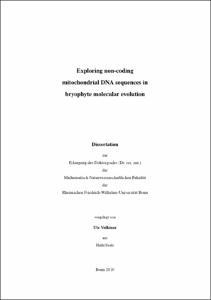Exploring non-coding mitochondrial DNA sequences in bryophyte molecular evolution

Exploring non-coding mitochondrial DNA sequences in bryophyte molecular evolution

| dc.contributor.advisor | Knoop, Volker | |
| dc.contributor.author | Volkmar, Ute | |
| dc.date.accessioned | 2020-04-15T14:04:51Z | |
| dc.date.available | 2020-04-15T14:04:51Z | |
| dc.date.issued | 28.04.2010 | |
| dc.identifier.uri | https://hdl.handle.net/20.500.11811/4566 | |
| dc.description.abstract | The thesis presented here focussed on the molecular evolution of non-coding mitochondrial DNA in liverworts and mosses. To address remaining questions in moss phylogeny, three mitochondrial gene regions were investigated and established as novel molecular markers: the nad5-nad4 intergenic spacer region (Wahrmund et al. 2009) and the two group I introns in the cob gene and cox1 gene (cobi420, Wahrmund et al. 2010 and cox1i624, Volkmar and Knoop subm). Phylogenetic trees based on the single loci and concatenated data sets identified a placement of Catoscopium, Drummondia and Timmiella in the basal Dicranidae, proposed the exclusion of Gigaspermaceae from the Funariidae and a potential sister relationship of the nematodontous moss classes Tetraphidopsida and Polytrichopsida (Wahrmund et al. 2009, 2010). A different resolution of the basal-most moss taxa by chloroplast and mitochondrial markers was observed (Volkmar and Knoop subm) and its implications on molecular and morphological evolution in mosses discussed. The hitherto assumed slow evolution of the mitochondrial genome in liverworts was contrasted with the discovery of recombinational activity in the intergenic region of the trnA-trnT-nad7 cluster, an ancient gene arrangement that is also present in algae and mosses. During liverwort evolution, an inversion and at least three independent losses of the trnT and adjacent spacer regions resulted in independent size decreases (Wahrmund et al. 2008). The nad7 gene, part of this gene cluster, is a pseudogene in all jungermanniid and marchantiid liverworts investigated. An ancient gene transfer to the nuclear genome occurred probably in the common ancestor of both classes, more than 350 million years ago (Groth-Malonek et al. 2007b). The exceptionally long retention of the pseudogene indicates an underlying but yet unknown function. In the three haplomitriid liverwort genera Haplomitrium, Apotreubia and Treubia, however, the mitochondrial nad7 gene is intact and functional and experiences an extremely varying degree of C-to-U RNA editing, a modification of mRNAs in plant organelles to reconstitute conserved codon identities. | en |
| dc.language.iso | eng | |
| dc.rights | In Copyright | |
| dc.rights.uri | http://rightsstatements.org/vocab/InC/1.0/ | |
| dc.subject | bryophytes | |
| dc.subject | plant mitochondrial DNA | |
| dc.subject | mosses | |
| dc.subject | liverworts | |
| dc.subject | phylogeny | |
| dc.subject | recombination | |
| dc.subject | pseudogene evolution | |
| dc.subject.ddc | 580 Pflanzen (Botanik) | |
| dc.title | Exploring non-coding mitochondrial DNA sequences in bryophyte molecular evolution | |
| dc.type | Dissertation oder Habilitation | |
| dc.publisher.name | Universitäts- und Landesbibliothek Bonn | |
| dc.publisher.location | Bonn | |
| dc.rights.accessRights | openAccess | |
| dc.identifier.urn | https://nbn-resolving.org/urn:nbn:de:hbz:5N-21081 | |
| ulbbn.pubtype | Erstveröffentlichung | |
| ulbbnediss.affiliation.name | Rheinische Friedrich-Wilhelms-Universität Bonn | |
| ulbbnediss.affiliation.location | Bonn | |
| ulbbnediss.thesis.level | Dissertation | |
| ulbbnediss.dissID | 2108 | |
| ulbbnediss.date.accepted | 16.04.2010 | |
| ulbbnediss.fakultaet | Mathematisch-Naturwissenschaftliche Fakultät | |
| dc.contributor.coReferee | Frahm, Jan-Peter |
Dateien zu dieser Ressource
Das Dokument erscheint in:
-
E-Dissertationen (4316)




